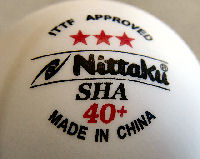
A detailed review of the new 40+ plastic table tennis ball from Nittaku. Comparison are made to current celluloid balls in terms of size, uniformity, colour, bounce, performance in play and durability. Are these balls better than the first generation of plastic balls? How do they compare to the celluloid balls?
Read more in the review below.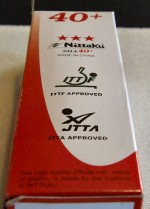
The packet
Pictured right is the packet these balls come in, a packet of 3. If we look closely at the bottom of the packet, you’ll notice a code, which actually tells you when the balls were produced:
 The date code on this packet is XGAD, which means the balls were produced in July 2014, so these are quite recent!
The date code on this packet is XGAD, which means the balls were produced in July 2014, so these are quite recent!
Here is how the codes work:
The date code consists of 4 characters: the first 2 for the month and the last 2 for the year.
Month and year are encoded using the capital letters from A to I for the numbers 1 to 9 (A = 1; B = 2; etc. up to I = 9; X = 0).
Examples:
a) ABXC means 1203, which is decoded as December 2003.
b) XEAA means 0511, which is decoded as May 2011
This date code system is mandatory for all ITTF approved ball brands.
So the code for this packet translates to 0714, which is July 2014.
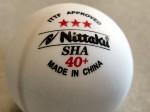 Visual Inspection
Visual Inspection
Pictured right is a close-up of this new plastic ball from Nittaku (click on pictures to zoom in).
As you can see the ball is 3* competition and ITTF approved, and has the 40+ marking indicating it’s made from the new plastic material.
Note that it’s made in China, not like the premium celluloid balls which are made in Japan (Nittaku also already has celluloid made in China for many years which are marked different to the premiums).
 Note also that this is a seamed ball just like the current celluloid balls, as you can clearly see the (hidden below the surface) seam on the ball pictured right marked by the arrow.
Note also that this is a seamed ball just like the current celluloid balls, as you can clearly see the (hidden below the surface) seam on the ball pictured right marked by the arrow.
Colour / brightness
Pictured below is a group of balls, including the 3 nittaku balls out of one packet, and a (used) Double Fish celluloid ball, chosen because the colours and logo looks somewhat similar.
The plastic balls look a little brighter and whiter, but the difference is not great, so I don’t think it will affect visibility significantly.
Ball Size
The new tolerance for plastic balls was changed by the ITTF (without proper justification or a vote I should add, but that’s another story) to 40.00 to 40.60mm. I measured the three in the pack, and compared to two celluloid balls that I had lying around. Here are the measurements:
As you can see from the pictures above, two of the Nittaku 40_ balls were quite similar, one was significantly bigger. I took the measurement several times just to be sure, and the values were very close every time. All balls are obviously well within tolerance.
As you can see from the bottom two pictures, the DHS and Double Fish celluloid balls are significantly smaller, so we can except roughly a 0.5mm increase in ball size, which is quite noticeble with the naked eye.
Uniformity
Although I don’t have proper equipment to measure uniformity in size, I checked the ball size with the vernier on different axis, and the difference was very little, probably comparable to my measurement errors. I also spun the balls on the table, which is a known method for finding balls that are irregularly shaped, and I did not notice anything unusual, so I was satisfied these balls are comparable in roundness to good celluloid balls.
Bounce test
A simple bounce test of a plastic and celluloid ball side by side, from about 50cm was performed and repeated many time. From this test it was quite clear that the Nittaku plastic balls bounce lower, as a guess about 5%. How significant this is will be determined in play.
Performance during play
I took the new balls to our club (Brighton Table Tennis Club), and spend about 3 hours playing with the new balls, comparing them to celluloid balls, and discussing our finding amongst fellow players and friends there. Most of us are in the top few divisions in Adelaide, so we have a fair idea of equipment and performance.
These are some of our finding and comments:
1. The balls feels heavier
Several players immediate commented that the ball felt heavier. Although I don’t have the equipment to measure the weight of these balls, I’ve talked to other people that have tested plastic balls and who did weigh them, and they found that it was not weight that was significantly different, but the hardness of the ball – harder balls tend to feel heavier.
No one really had an issue with the ball feeling heavier, in fact some people prefer this.
2. The ball feels slower
Virtually everyone agreed that the balls felt slower… some did not think it was that significant, other felt it had quite an affect on the game. The ball felt slower in both the short game and play away from the table. There appeared to be still plenty of power to put a high ball away though. Some felt that this was significantly enough to produce longer ralleys, and I would personally agree with this.
3. Less spin on loops
Most agreed that standard loops seemed to produce less spin. The evidence was less dip after it hit the table and less curve on the ball, and the heavy loops were easier to block.
There did appear to be potential to put plenty of spin on the ball though, as slower spinny loops were still hard to control and caused over-hitting by the opponent. Some balls did still kick on the table, but it was a little different to the kick of celluloid balls.
Especially ralleys away from the table, where players like to curve the ball onto the table is likely to be a little less spectecular, although the increase length in ralleys may compensate for this some what. There were still some very good ralleys, so this aspect is not a deal breaker IMO.
4. Serves and returns
I did not notice any significant difference in serves or returns, and spin seemed to be just as strong and affective. No one else had any issues here either.
5. Blocking and pushing with long pimples
As a long pimple player on my backhand (tibhar dtecs OX) I was very interested to see how this ball would affect my play. Blocking (chop block) against loops seemed to be more effective with these balls – balls come off at a lower angle and bounce shorter, both of which are a bonus. The amount of spin reversed still seemed just as much.
Aggressive pushing against backspin balls was also still as affective with similar reversal. I noticed the dtecs was a little less affected by heavy backspin, which was nice to see, as this was always a weakness of this rubber.
So I don’t think there is a downside for players that play this style, and there may actually be some advantages.
6. Chopping with long pimples
I also chopped (away from the table) against loops with the long pimples, and found them to be quite similar to celluloid, and I was still able to produce heavy enough backspin to trouble the looper. The balls seemed to come a little slower, which made it easier to get it.
I also noticed that my chops were landing somewhat shorter but also lower. This again could be an advantage for choppers as a low and heavy backspin ball is harder to attack.
7. Hitting / Blocking
This seemed definitely easier with the plastic balls, which is think it’s because the balls grips less on the rubber, so the angle of bat is less critical. Controlling the pace of blocks seems easier, probably because the balls just bounce a little slower of the ball.
I expect hitters, particularly short pimple hitters, may get an advantage from these balls, as they definitely seem easier and more forgiving to hit.
Durability
Well I’m happy to report that none of the balls were broken during our session… and some of us hit the balls pretty hard. What I did notice at the end of the session is that the balls seemed to have lost their initial ‘matt’ look, and appeared to be rather shiny. For celluloid balls this does not usually happen until many sessions later. However I did not experience any degradation in performance, so I really have no evidence that this shiny look affects play significantly.
Conclusions so far
Although I’ve only had one session so far, and I await for more comments from other people that are trying the ball, I’m pleasantly surprised by these balls so far, particularly after my rather negative experience of a seamless DHS plastic ball (which does not appear to have proceed in production as DHS now makes seamed balls).
Although none of the players were particularly keen to change over the new balls, all agreed that a change to the new ball would not affect their games drastically, and that they would be able to adjust quite quickly.
The higher cost of these new balls is still a major concern, but hopefully this will reduce as mass production takes off.
to be continued….



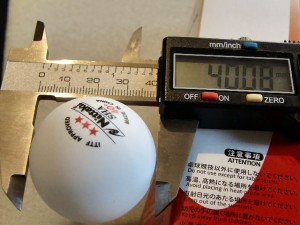
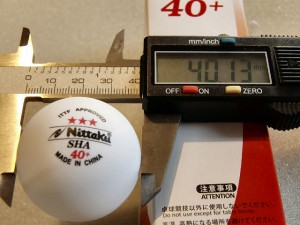

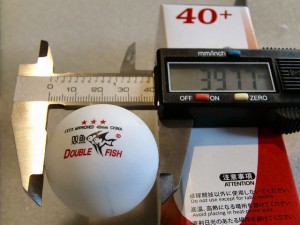
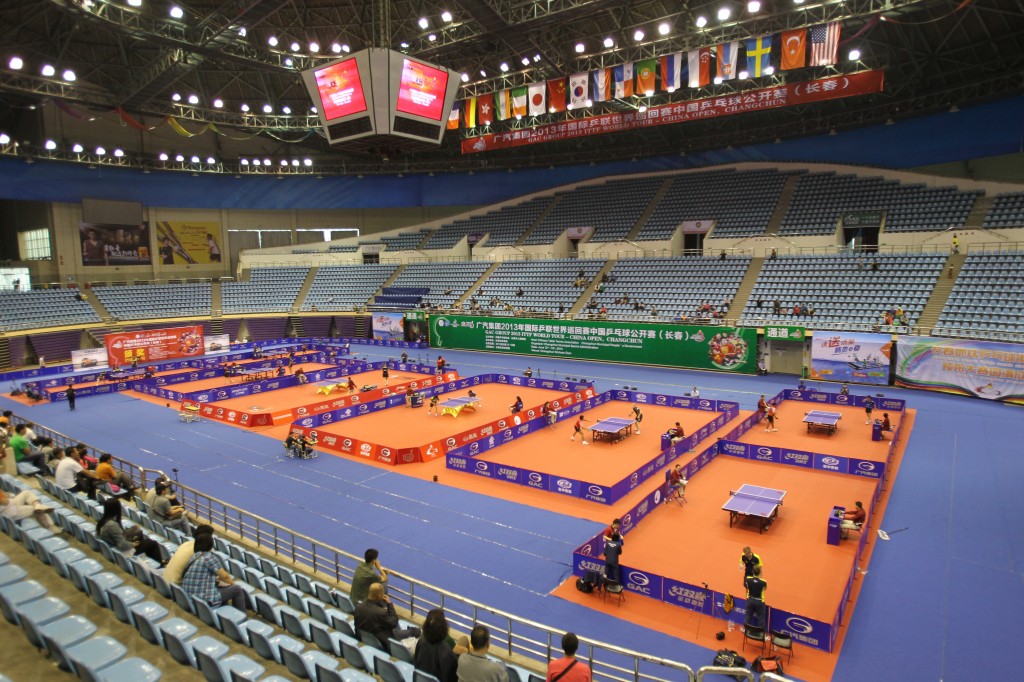
One technical thing – that is not a Vernier caliper.
Could you let me know if you find out anything else?
Thanks a lot!
My local TT club. Not sure where they got them. I’ve emailed Nitakku about the embossing question. I got some obviously counterfeit DoubleFish last year – and they had *no* date code, embossed or otherwise. I bought them on eBay knowing they were probably fake since they were so cheap. I kept them & ended up using them in my Newgy 2040 robot.
Good review. I noticed in the photograph above the date code appeared embossed on the box. The box I have has a date code, but it is printed, not embossed. One of my new Nitakku Premium 40+ balls cracked almost immediately during light serve/return practice yesterday. I’m wondering if the balls are counterfeit. I read another blog about a rash of fake DoubleFish balls and one sure way to tell if the balls were fake was the lack of an embossed date code on the box flap. Wondering if the same is true for Nittaku – if the date code is not embossed, is the ball likely a fake? Might explain sudden cracking I experienced.
Thanks for the information!
Yes it’s possible. Where did you buy it, if you don’t mind me asking?
hi how can buy from these balls?
i,m pleyer in iran
I find that slower balls hit the table and bounce straight up. If you are waiting for the ball to come to you, it won’t. I think spinny serves are much easier to return and spin in general is less. We played a few matches and then went back to the 40’s there is a real difference. I have some to the premium 3 Star Nittaku plastic balls (they do not say SHA on them) and they do not have a seam. I can see how manufactures of equipment will be coming out with a whole new line of rubbers and blades for the new ball (here we go again).
For the USATT to come out a month before the Nationals and inform everyone that they will be using the new plastic ball is beyond logic. I can’t wait to hear the players complain at the tournament. Oh yeah, and to only be able to buy them at Paddle Palace, if I had a table tennis business I would be very upset.
New plastic balls really are a nightmare to me! Heavier, less spinny, less bouncy, etc., requiring a lot more power and efforts to loop the ball back.